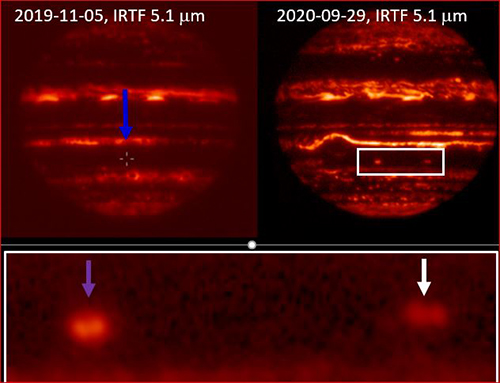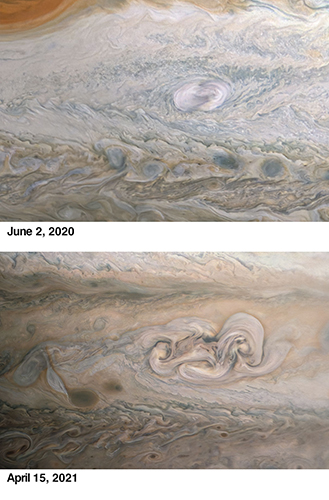The latest developments of Jupiter’s STB May 2020 outbreak (“Clyde’s Spot”)
- 1Astronomical Society of Southern Africa,Centurion, South Africa (clyde@icon.co.za)
- 2Universidad del País Vasco, UPV/EHU, Bilbao, Spain
- 3British Astronomical Association, London, UK
- 4Jet Propulsion Laboratory, California Institute of Technology, Pasadena, CA, USA
- 5Planetary Science Institute, Tuscon, AZ, USA
- 6Association of Lunar and Planetary Observers-Japan
- 7Pasadena City College, Pasadena, CA
- 8New Mexico State University, Las Cruces, NM, USA
The latest developments of Jupiter’s STB May 2020 outbreak (“Clyde’s Spot”)
C.R. Foster1, R. Hueso2, P. Iñurrigarro2, A. Sanchez-Lavega2, J.H. Rogers3, G.S. Orton4, C.J. Hansen5, T. Momary4, S. Mizumoto6, K.H. Baines4, S. Brueshaber4, J. Yan7 , E. Dahl8
(1) Astronomical Society of Southern Africa, Centurion, South Africa (2) Universidad del País Vasco, UPV/EHU, Bilbao, Spain (3) British Astronomical Association, London, UK (4) Jet Propulsion Laboratory, California Institute of Technology, Pasadena, CA, USA (5) Planetary Science Institute, Tuscon, AZ, USA (6) Association of Lunar and Planetary Observers-Japan (7) Pasadena City College, Pasadena, CA (8) New Mexico State University, Las Cruces, NM, USA
Email: clyde@icon.co.za
Introduction & Summary
The notable outbreak in the South Temperate Belt (STB) latitudes, bright in the methane absorption band, that was observed by the lead author on 2020 May 31, and which would become known as “Clyde’s Spot” in the Pro-Am planetary community, has been the subject of intense research over the last year [1,2]. NASA’s Juno spacecraft imaged the storm two days after its onset with the JunoCam instrument, obtaining very high-resolution observations which showed the storm as a bright plume within a cyclonic vortex, but which faded quickly in methane band images. The remnant of the outbreak evolved into a dark feature in visible wavelengths on a timescale of 5-7 days and remained visible throughout the rest of 2020, being designated as DS7 (Dark Spot 7) following the convention of previous features in the region. This long-lived feature was regularly monitored by the amateur community and was imaged in several sets of Hubble Space Telescope observations. On 15 April 2021, ten and a half months after the initial convective outbreak, the Juno ground track during its 33rd perijove fell over the remnant of the outbreak, revealing fascinating details of its transformation into a Folded Filamentary Region (FFR), auguring well for possible further future expansion.
Early developments and Pre-solar conjunction observations
The methane-bright eruption diminished within the first few days of detection, leaving a small, dynamic, complex feature which showed varying combinations of light and dark features over the following months. From July through to October observations at 5 microns from the NASA IRTF indicated a bright spot showing that the initial plume had been replaced by a clearing in the upper atmosphere. In ground-based observations obtained by many amateurs over the remainder of the year, the general perspective was that of a dark spot, leading to the designation of DS7. Towards the end of the year, as Jupiter approached solar conjunction, the quality of images reduced, although amateur observations were able to track DS7 through to early January, a few weeks before conjunction. The anticipated development of a substantial dark STB segment did not occur, and there was some thought that DS7 might dissipate during the period of conjunction.
Post-solar conjunction detection and confirmation
Solar conjunction occurred on 29 January 2021, and when regular amateur imaging recommenced in March, a poorly defined dark feature was noted at the anticipated longitude and latitude. Drift charts generated by S. Mizumoto (ALPO-Japan) and the planetary science group at University of Bilbao (R. Hueso et al) confirmed the feature was indeed DS7 and was accordingly tracked and imaged as comprehensively as possible. Anther STB cyclonic dark spot, DS6, which had been following DS7 prior to solar conjunction, was initially unable to be identified.
NASA Juno Perijove 33 (PJ33)
It became clear well before the PJ33 flyby that the track would take the spacecraft over the DS7 region. Some reasonably high-resolution images were produced by the amateur community before during and after the flyby, showing some light and dark structure.
Much interest was raised by the images of DS7, which showed that it had developed a Folded Filamentary Region (FFR) structure. This indicates that the initial outbreak was the onset of conversion of a small cyclonic vortex into a FFR. The uncertainty regarding the fate of DS6 was resolved, as the images showed a new, well-defined pale orange cyclonic oval on the north-east edge of Oval BA. Ongoing observations suggest that the oval may have been temporarily captured by Oval BA.
Conclusion
The only similar methane-bright outbreaks previously recorded in the cyclonic STB latitudes were in large, structured sectors at the end of their life: the so-called STB Remnant in 2010 and the STB Ghost in 2018 [3,4]. These generated rapidly expanding disturbances that converted these long cyclonic circulations into dark turbulent STB segments. Initially at least, Clyde’s Spot, being in a very compact cyclonic vortex, had not shown signs of early expansion. However, the latest images from Juno PJ33, showing the development of the FFR structure, appear to indicate potential for longer term development of this feature, which could become a more substantial dark turbulent STB segment. In contrast to the 2010 and 2018 events, this would represent the growth of a new cyclonic feature rather than transformation of an older one.
Figures:
Left: ‘Clyde’s spot’ in 889 nm methane band. Right: IRTF observations, before and after Clyde’s Spot appeared. (lower panel DS6(L) and DS7 (R) on 2020 Sept 29 Bottom: “Clyde’s Spot” at PJ27 (top) and its developing remnant at PJ33(bottom)-credit NASA/Kevin.M Gill.

References:
- Foster, C. et al. A rare methane-bright outbreak in Jupiter's South Temperate domain, 14thEPSC 2020, id. EPSC2020-196
- Hueso, R. et al. Long-term effects of short-lived convective storms in Jupiter's cyclones, DPS#52 2020, id. 100.04
- J. Rogers (2019), ‘Jupiter’s South Temperate Domain, 2015-2018’. https://britastro.org/node/17283.
- P. Iñurrigarro et al. (2019-20). ‘Observations and numerical modelling of a convective disturbance in a large-scale cyclone in Jupiter’s South Temperate Belt.’ Icarus 336 (2020), paper 113475.
How to cite: Foster, C., Hueso, R., Iñurrigarro, P., Sanchez-Lavega, A., Rogers, J., Orton, G., Hansen, C., Momery, T., Mizumoto, S., Baines, K., Brueshaber, S., Yan, J., and Dahl, E.: The latest developments of Jupiter’s STB May 2020 outbreak (“Clyde’s Spot”), Europlanet Science Congress 2021, online, 13–24 Sep 2021, EPSC2021-121, https://doi.org/10.5194/epsc2021-121, 2021.

